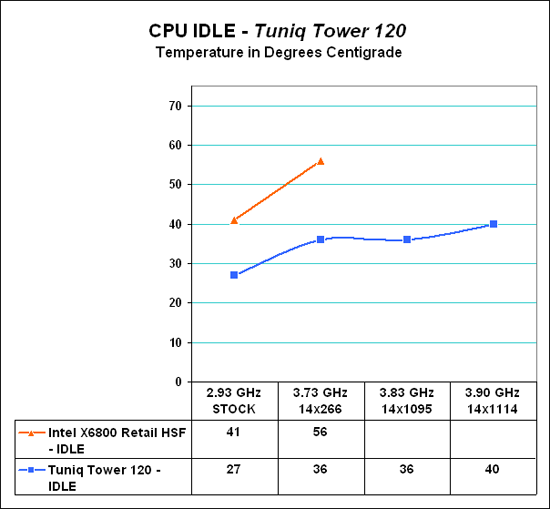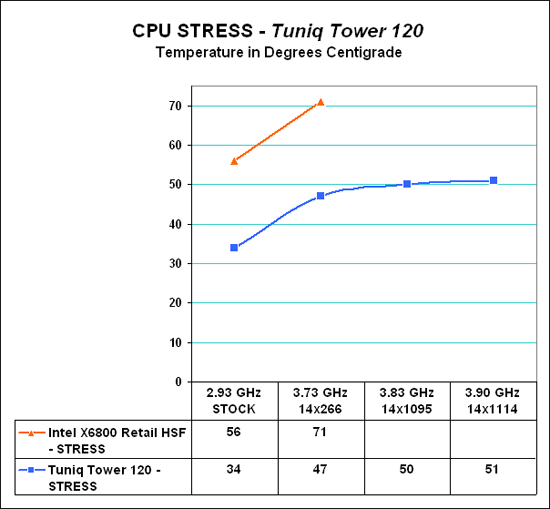Tuniq Tower 120: Air Cooling to the Max
by Wesley Fink on January 15, 2007 12:01 AM EST- Posted in
- Cases/Cooling/PSUs
Cooling Results
Both the retail Intel X6800 HSF and the Tuniq Tower 120 perform well at idle. Even at this base level, however, the effectiveness of the Tuniq Tower 120 is still clear.
Where the very good Intel stock cooler keeps the X6800 at 41C, the Tuniq manages 27C, which is a huge difference at stock idle speeds. As the processor is pushed to its highest stable overclock using the retail HSF, the delta increases. At 3.73GHz the retail HSF is running at 56C, compared to an extremely cool 36C with the Tuniq at the same speed. The Tuniq allows the X6800 to reach even higher overclocks, to a stable 3.90 GHz. Even at the maximum overclock on this CPU with the Tuniq, idle temperature is still a modest 40C, less than the stock speed temperature of the retail Intel HSF.
It is very easy to measure the effectiveness of a cooling solution at idle - when the computer is doing nothing except running the temperature measurement program. It is more difficult, however, to effectively simulate a computer being stressed by all of the conditions it might be exposed to in different operating environments. Frankly, for most home users CPU power is most taxed with contemporary gaming. Therefore our stress test simulates running a demanding contemporary game.
The Far Cry River demo is looped for 30 minutes and the CPU temperature is captured at 4 second intervals with the NVIDIA monitor "logging" option. The highest temperature during the stress test is then reported. We did try other variations in "stressing" the CPU. One option was multi-tasking running Super Pi with the Far Cry River looping. This did almost halve gaming frame rates and push CPU utilization to near a constant 100%. The multitasking test setup, however, did not produce higher temperatures than looping the Far Cry River demo. For that reason, we settled on the simple stress test of looping a demanding Far Cry demo for 30 minutes.
Cooling effectiveness compared to the retail HSF improves even more with the Tuniq Tower 120 when measured under stress conditions. It appears the Tuniq becomes even more effective as greater demands are placed on cooling.

The delta under stress conditions at stock 2.93GHz speed is 22C - 56C to 34C. This compares to the delta at stock idle of 14C. As we saw with idle speeds, the difference increased as we overclocked, with a difference of 24C (71C to 47C) at the 3.73GHz overclock. With the Tuniq speed could be pushed another 170 MHz to 3.90 GHz, with the stress CPU temperature of 51C - still 5C below the stress temperature of the retail HSF at stock speeds.
It would be an understatement to say the performance of the Tuniq 120 is impressive in cooling the CPU. In all cases the Tuniq cooled the CPU better than the stock Intel retail HSF under the same conditions at stock speed. This was true even with the X6800 pushed about 1000MHz beyond the fastest available Core 2 Duo CPU.
As for the overclocking abilities of the CPU, they will vary at the top. This particular CPU does higher FSB speeds than any X6800 we have tested, but the 3.9GHz top speed is pretty average among this CPU cooled with the Tuniq Tower 120. A few of the other processors tested with the Tuniq reach just over 4 GHz, but the range has been 3.8 to 4.0GHz. Stock cooling generally tops out 200 to 400Mhz lower, depending on the CPU, on the processors tested in our lab.










50 Comments
View All Comments
imaheadcase - Monday, January 15, 2007 - link
I just put that artic cooler freezer Pro 7 (thats a mouthfull) on to replace my stock HSF, that itself made a HUGE difference. I got it for $25 at newegg.Before, I was running top speed 1.86ghz @ 2.8ghz with stock HSF. When i put on Freezer pro I hit 3.2ghz without any voltage change, but now its 48c at 3.2ghz vs 62c at 2.8ghz! Pretty impressive no matter how you dice it.
I'm guessing its just all heatpipe heatsinks that help a ton with cooling over stock HSF.
Araemo - Monday, January 15, 2007 - link
Not all 'heatpipe heatsinks', you can still design a heatsink badly with heatpipes. But most of the highest performance heatsinks use heatpipes to increase their efficiency, or to allow amazing masses of metal that would not fit around the CPU socket directly. My current heatsink looks a bit like an old style heatsink, but with 4 heatpipes coming out of the thick base and extending through the fins an inch higher and off to the sides.. it cools VERY well.I've also seen similar looking heatsinks w/ heatpipes that cool worse than stock AMD and Intel heatsinks.
slayerized - Monday, January 15, 2007 - link
It is indeed a fair way to compare this with the stock heat sink. It would be more insightful to compare the results with other available products such as Zalman. Good review anyway!Wesley Fink - Monday, January 15, 2007 - link
Other cooling reviews are in the works. Eventually we will have a cooling database that will compare all the top cooling solutions.We have found the Intel Retail HSF to be a decent cooler - particularly on a C2D. We needed to test the Retail Intel as a base line for future cooling tests.
mostlyprudent - Monday, January 15, 2007 - link
Very nice article. I would love to see a review of the Thermalright HR-01-775. I have heard reports that it is capable of passively cooling an E6400.poohbear - Monday, January 15, 2007 - link
yea i just wanna echo the above sentiment that we all know its better than stock, but how about comparing it to the top 5 coolers on the market to get an idea of how good it is? nonetheless, nice to finally see a heatsink review on anandtech.:)shank2001 - Monday, January 15, 2007 - link
Don't forget to test the Scythe Infinity when you do your comparisons. I think it may just beat the Tuniq! Amazing heatsink!xsilver - Monday, January 15, 2007 - link
I would like to request reviews of HSFs in the lower price bracket as well as this one. ($30 us approx.) eg. are you getting the extra $20 worth if you go for the tuniqalso the tuniq isnt readily available in some parts of the world :( so reviews of more easily obtained products would be good.
Wesley Fink - Monday, January 15, 2007 - link
A low cost cooler roundup is in the works. Roundups always require lots of bench time so it will be several weeks before you will see the roundup at AT.xsilver - Monday, January 15, 2007 - link
oh alsoanother good idea may be to also bench all new coolers against paradigm coolers of the past the people may be privvy to keeping/using such as the zalman 7000 / thermalright xp-90/120 and seeing how they compare to newer HSF units or even if they beat stock coolers anymore?